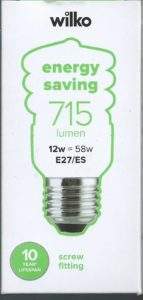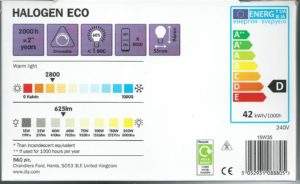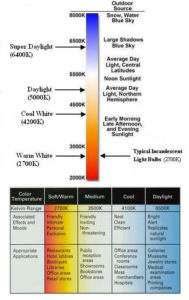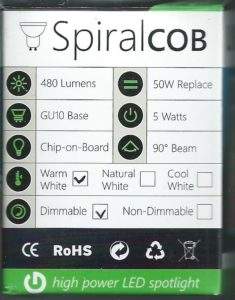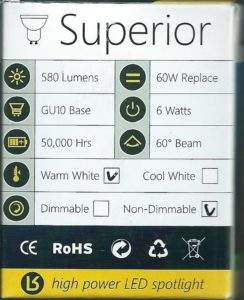Selecting a suitable light fitting, or the correct lamp(s) for a light fitting, has become more complicated since the introduction of energy saving lighting. Several factors need to be considered and this page is intended to try and explain some of the terminology.
Backgound: Traditionally houses had one pendant lamp holder in each room, a fluorescent strip light in the garage, (and maybe kitchen), and an enclosed globe fitting in the bathroom. Most light bulbs were GLS filament lamps and were selected by power rating, shape & fitting type. ( e.g. 25, 40, 60, 100 or 150watts. Pearl or clear glass. Round or candle shape. Bayonet or screw thread fitting). Later, spot lamps, automatic security lights and dimmer switches became common place, but it was still easy to buy a new light bulb from Woolworths, knowing it would work when you get home. Lights were cheap, easy to select and fit, but they were not very energy efficient.
The source of confusion: Misuse of ‘Watts’ to describe light bulbs has created confusion around how bright modern energy efficient lamps are. Professional photographers will be familiar with ‘Lux’ & ‘Lumens’ as the units of light intensity, where as ‘Watts’ is the measure of power consumed by the light.
Modern energy saving lamps produce more light, (Lumens/Lux), from the power, (Watts), consumed. LED lamps also have colour temperature characteristics, (Warm/Cool), so more factors need to be considered when selecting light bulbs.
The following brief descriptions summarise common terminology found on modern lighting; Watts, Lumens, Lifespan, Colour temperature, Beam angles, Dimmers, Cap styles (bayonet, screw, GU10, MR16, G9, G4 etc).
Watts: is the amount of power consumed by a device, it is the Voltage x Current. Increased watts means more current, more current means more heat. With lighting more heat is greater waste. Many lamp holders and lamp fittings will have a maximum wattage rating quoted due to the heat generated by higher wattage lamps. Limitations include materials used on lamp-holders, shades, or if enclosed or an open lamp. (The heat produced by a traditional 100watt light bulb can cause a significant burn if touched with a bare hand)
Lumens and Lux: relate to the light generated and the intensity on a surface. As light intensity decreases the further away from the source, distance as well as brightness are taken into account. Historically a measurements called foot candles was used. (The brightness of one candle measured one foot away.) Lux is the metric measurement of lumens per square meter. 1 Lux = 1 lumen per square meter. {one Lux is approx. 0.093 foot candles}
Fuel efficiency
Improved efficiency is achieved by greater output for the same fuel consumption, (e.g. more miles per gallon in a car). More light out, (lumens), for the same power, (watts), is the measure of lighting efficiency. To be considered energy efficient, lamps should produce a minimum of 40 lumens-per-watt. (old types of light bulb that cannot meet this target are being phased out)
Finding the lumens per watt was difficult where the lumens was not in the same print as the watts. e.g. watts clearly visible on the front, lumens in small text on the back or side. A couple of examples illustrate this point..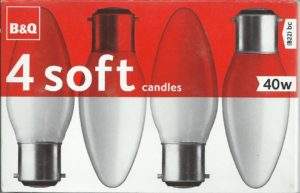
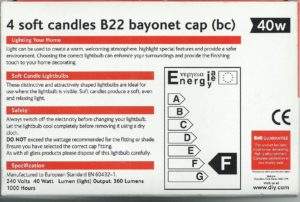
A B&Q box of candle lamps:
40watt power consumption, (fuel in), is clearly written on the front. But 360lumens, (light out), is in tiny writing, last but one line from the bottom, on the rear of the box. [360/40 = 9 lumens per watt].
{you may need to zoom your screen to read the small lumens text!}
 A similar Wilkinson box of candle lamps:
A similar Wilkinson box of candle lamps: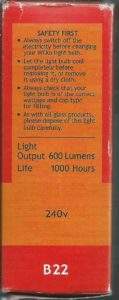
60watt power consumption large print on the front. But 600lumen, is on the side panel. Larger writing than the B&Q box, but still small. [600/60 = 10 lumens per watt].
Sometimes the lumens is not written anywhere on the packaging! A rough rule-of-thumb, with traditional GLS filament lamps is about 10 lumens per watt. So 60 watt lamp is approx 600 lumens, 100 watt lamp is approx 1000 lumens.
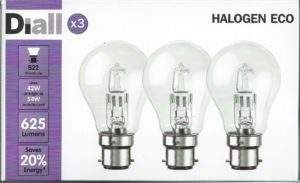 Newer packaging is better; e.g. A B&Q halogen lamp clearly states 625 lumens and the 42 watt is smaller. [625/42 = 14.9 lumens per watt]. Still not a very energy efficient lamp but improving. (The box claims it is equivalent to a 54w lamp, )
Newer packaging is better; e.g. A B&Q halogen lamp clearly states 625 lumens and the 42 watt is smaller. [625/42 = 14.9 lumens per watt]. Still not a very energy efficient lamp but improving. (The box claims it is equivalent to a 54w lamp, )
A Wilkinson compact fluorescent lamp, has 715 lumens in large print and 12 watts much smaller, [715/12 = 59.6 lumens per watt]. A more reasonable energy efficient lamp. (This is claimed to be equivalent to a 58watt lamp.)
Colour and Duration
Expected lifespan: In addition to efficient lumens-per-watt, a longer lifespan is needed due to the increased cost of energy efficient lamps. (Traditional filament lamps were available at less than £1 each). The average lifespan is normally given in hours, (e.g. 1000h or 1000hours again in small text), and typical filament lamps were 1000 or 2000 hours, or sometimes 3000 hours called ‘long-fife’. Whereas energy efficient lamps typically start at 10,000 hours up to 50,000hours. {note: 365days x 24hours = 8760 hours per year.}
A light quoted as 25,000 hours could theoretically be permanently switched on for 1044+days or over 2 years and 10 months. If allowing for average hours per day, a 25,000hr lamp could last for over 11years if only used for 6 hours per day. (6hrs x 365days x 11.4years = 24966hrs). Average lifespan figures are calculated by testing samples of lights, so if the majority fail after 2000hours they are defined as 2000hour lamps, even though a percentage will fail earlier and others last much longer. Other factors can reduce average lifespan; Bumps and knocks in transit. Electrical surges and fluctuations of supply. Extreme heat or cold. Enclosed light fittings with reduced air flow around lamp. Frequent switching on/off.
Colour temperatue, Kelvin: When shopping for clothes artificial light can make colours look different to appearance outside in daylight. These variations of light are known as the colour temperature. Light temperature is measured in Kelvin, (k), and often included on modern light packaging. Typically a four digit number followed by a ‘k’. Others may just describe a lamp as ‘cool’ or ‘warm’ or ‘daylight’. (e.g. 2700k is a warm light, 4200k is a cool light, 5000k is near daylight. A candle may be 2000k and sunlight 6000k+). Traditional filament lamps have a warmer light. LED’s come in numerous temperature options. The B&Q lamp illustrated earlier also have colour chart on the back showing the Kelvin rating as 2800k.
Some internet lighting suppliers have informative pages about lighting and colour temperature. e.g. http://www.thelightbulb.co.uk/resources/colour_temperature Cooler lighting can be effective in bathrooms, showers, hallways, study/office, garage/workshops where a bright crisp light does not look out of place. Whereas lounges, bedrooms, dining rooms need warmer lighting to feel more relaxing and cosy. Kitchens can be a mix of both warm or cool. Cooler light over work areas, but warmer if sitting around a table.
Colour temperature is very important when selecting LED lighting, as they can be vary clinical and cold looking compared to filament lamps, halogen or even some compact fluorescent lights.
Spot lamps and beam angles
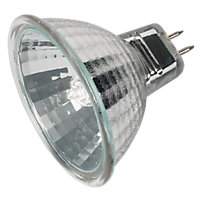
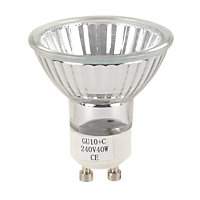
A traditional pendant lamp emits light in a 360º pattern, with just the base fixing and any lamp shade restricting the light. Whereas recessed ceiling spot lamps, (e.g. GU10 or MR16 fittings), have a flat face, emitting light in a beam similar to the light from a hand torch. Most miniature spot lamps will also have their beam angle printed on the box. A narrower beam will give greater variation of lux levels on surfaces inside and outside of the beam footprint compared to a wider beam. 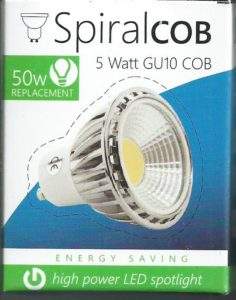
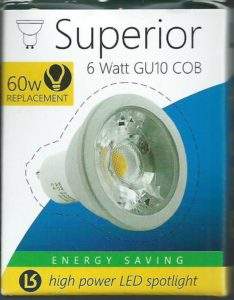
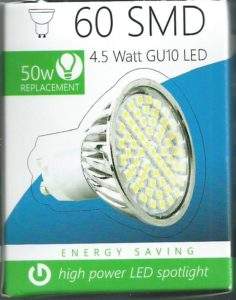 Variations from 35º to 120º are commonly available, which will make significant difference to the lighting effect in a room. Other factors such as the quantity of lamps in a room, or if they are for highlighting a feature or general room lighting, need to be considered when selecting a suitable beam angle. .
Variations from 35º to 120º are commonly available, which will make significant difference to the lighting effect in a room. Other factors such as the quantity of lamps in a room, or if they are for highlighting a feature or general room lighting, need to be considered when selecting a suitable beam angle. .
Three example GU10 LED lamp boxes illustrated have a 4.5watt 380lumen with 120º beam angle, a 5watt 480lumen with 90º beam angle and a 6watt 580lumen with a 60º beam angle. Clearly there will be noticeable differences of light intensity even though they are all “warm white” and within 1.5watts of power as each other. (The lumens per watt range from 84 to 96, so relative to the traditional filament lamp you get 8 or 9 times more light for the same power consumed.)
Dimming and Dimmers
Energy efficient lighting has added complications if you want dimmer switches, as not all LED’s are dimmable and not all dimmer switches can work low energy lighting.
Max and Min power rating: A dimmer switch has a maximum power (watts) that it can control. Too much power, (too many lamps), will either reduce the life of the dimmer or burn it out completely. Dimmers also need a minimum load for them to work correctly. Too small a load can cause flickering when trying to dim the lights.
A traditional domestic dimmer switch was typically rated from 60watts min, up to 250watts or 400watts max. So a light fitting with five 60watt lamps would be too big for a 250watt dimmer switch. Or a single 40watt lamp would be too low for the dimmer to work correctly at low levels. Or if you replaced four 50watt spot lamps with 4.5watt LED’s, what used to be a 200watt load, (ideal for a 60w->250w dimmer), is now an 18watt load. Too small for the 60watt minimum. Additionally the electronics inside some older dimmer switches is not compatible with many energy saving lamps.
Modern LED compatible dimer switches are available often with minimum loads of 10watts. So if replacing old lamps with low energy lamps in rooms controlled by dimmer switches, you will probably need to factor in replacing the dimmer switch as well. Assuming you have purchased dimmable lamps. (On the three illustrated LED boxes, it can be seen that the 6watt, right hand side, is a non-dimmable lamp.)
Cap style, (how the lamp connects to the light fitting)
Numerous types of physical connection exist between lamps and lamp-holders. Most of the common ones are illustrated below:
Bayonet: May be described as; Bayonet, Bayonet cap, Small bayonet, Miniature bayonet, B, BC, B22, BC22, SBC, B15, BC15 etc..
Available in large or small diameter lamp holders. They are quite robust and reliable, but the two small sprung pins which have to make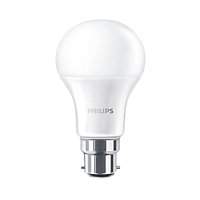
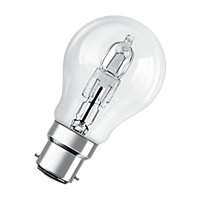
 contact with the lamps electrical terminals can deteriorate over time due heat generated by the lamp. They can become stiff so they do not spring up to connect with the lamp, so a new lamp fails to work in that holder. Some lamp holders have plastic parts that can become very brittle over time.
contact with the lamps electrical terminals can deteriorate over time due heat generated by the lamp. They can become stiff so they do not spring up to connect with the lamp, so a new lamp fails to work in that holder. Some lamp holders have plastic parts that can become very brittle over time.
Screw thread: May be described as Screw, Screw cap, Edison Screw, Miniature Screw, Small Edison Screw, S, ES, E27, SES, E14 etc..
Available in large or small diameter lamp holders. They are reasonable fail safe, but they do have two small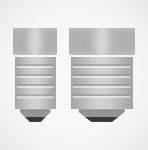 sprung metal
sprung metal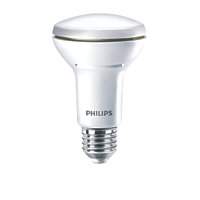
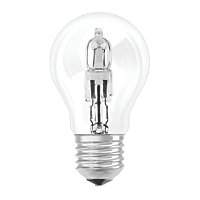
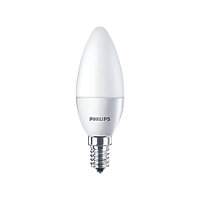 terminals, which should make contact with the bottom pin and side thread of the lamp for it to work. Heat and wear and tear with ageing can cause the metal terminals to fail to make contact with the lamp. Occasionally the thread can stick between the lamp and holder, causing the complete lamp holder to rotate when trying to unscrew and old lamp, or cause the glass body of the lamp to separate from the screw base. Great care should be taken removing old lamps that are stuck in the holder, as twisting the lamp holder can cause the wire connections to break off or short out or touch the inside of metal light fittings.
terminals, which should make contact with the bottom pin and side thread of the lamp for it to work. Heat and wear and tear with ageing can cause the metal terminals to fail to make contact with the lamp. Occasionally the thread can stick between the lamp and holder, causing the complete lamp holder to rotate when trying to unscrew and old lamp, or cause the glass body of the lamp to separate from the screw base. Great care should be taken removing old lamps that are stuck in the holder, as twisting the lamp holder can cause the wire connections to break off or short out or touch the inside of metal light fittings.
MR16: Small push fit lamp holders for low voltage lamps with two small pins.
Commonly used with 12v lamps and somewhere in the fitting or the supply wiring there will be a transformer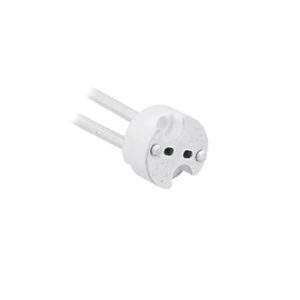 or LED driver to provide the correct voltage. If the wiring from transformer to the light is too long, or there are too many lamps off one transformer
or LED driver to provide the correct voltage. If the wiring from transformer to the light is too long, or there are too many lamps off one transformer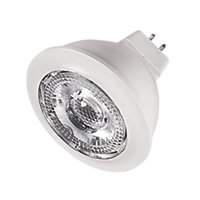

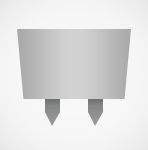 then the lamps will not operate at their full brightness due to reduced voltage.
then the lamps will not operate at their full brightness due to reduced voltage.
They have a small push-fit connection which can be a week point, where over time the quality of the contact between the lamp and the connector deteriorates to the point of failure. Faults due to spot lamps not working often relate to the failure of these connectors, or the transformer.
There are certain ‘zones’ within bathrooms where 230v lighting is not permitted, so these 12v are one possible solution, but as a general rule if looking for an equivalent physical size lamp a 230v GU10 option is a more reliable solution.
GU10 & GZ10: 230v connection for 50mm spot lamps.
Two very similar type lamp connections, GZ10 has a squarer edge and the GU10 has a small bevel angle. 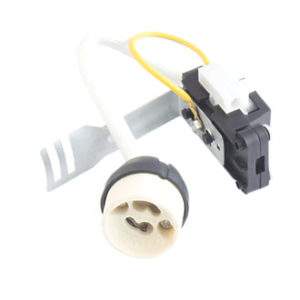 The difference is to ensure the wrong type of lamps cannot be installed in the wrong light fitting. GZ10 lamps are classed as cool beam because they radiate more heat through the back of the lamp and thus
The difference is to ensure the wrong type of lamps cannot be installed in the wrong light fitting. GZ10 lamps are classed as cool beam because they radiate more heat through the back of the lamp and thus the
the
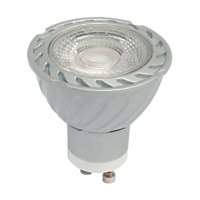 fitting has to be capable of dissipating this heat. GU10 lamps are more like a reflector spot lamp and throw light and heat forwards. Their fittings are not designed for the sort of heat that a GZ10 would radiate backwards.
fitting has to be capable of dissipating this heat. GU10 lamps are more like a reflector spot lamp and throw light and heat forwards. Their fittings are not designed for the sort of heat that a GZ10 would radiate backwards.
GU10 lamps can fit in a GZ10 holder but not vice-versa. As a general rule the GU10 lamp is the more common and is the one you are most likely to find when purchasing these spot lamps. Most LED’s of this size have the GU10 base. The fitting has two small keyhole shaped slots, the lamp is inserted then turned to lock it in place. They are a very robust and reliable lamp connector.
G9: A 230v connection small push fit lamp.
These 
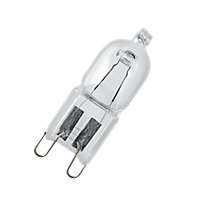 lamps are bullet or capsule type bulbs that simply push into the lamp holder. They are generally a reliable type of connection. Often used in external spot lamps or decorative internal lighting, especially the type with numerous arms or branches coming out from a base.
lamps are bullet or capsule type bulbs that simply push into the lamp holder. They are generally a reliable type of connection. Often used in external spot lamps or decorative internal lighting, especially the type with numerous arms or branches coming out from a base.
G4: A 12v connection small push fit lamp.
These lights are 12v, so they will have an associated transformer either built into the light fitting or in the supply wiring. They are a bullet capsule type of lamp with two small pins for the electrical connection. Often used in decorative lighting in 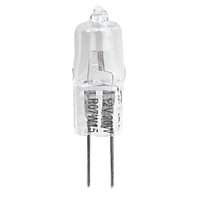
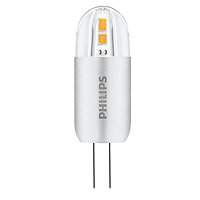 wardrobes, glass display cabinets, kitchen units, bathroom mirrors and cabinets etc.
wardrobes, glass display cabinets, kitchen units, bathroom mirrors and cabinets etc.
As with the MR16 push connector these can be prone to failure due to poor electrical contact. Can be a useful solution in bathrooms where 230v lights may not be permitted inside zones, but they can be a cause of many lamp failure problems. Over time due to heat, the connections lose their tension to maintain a good grip on the lamp, so if you hold or wiggle the lamp it may come on, but once you let go it goes off, at this stage it is generally cheaper to replace than try to repair.
R7S: Linear stick shape lamps.
The traditional halogen garden flood light lamp. Two common lamp lengths being 114mm and 80mm. They are a relatively wasteful method of lighting, they consume a lot of power, generate a lot of heat and don’t produce many lumens per watt. 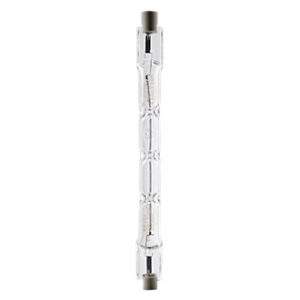 [ Two sample ratings are; 400watt, 9000lumen (22.5 lumen per watt), 80mm 120watt, 2300lumen (19.1 lumen per watt) ]
[ Two sample ratings are; 400watt, 9000lumen (22.5 lumen per watt), 80mm 120watt, 2300lumen (19.1 lumen per watt) ]
These lamps are often sold cheap and fitted as DIY tasks, in inappropriate locations, causing light pollution over adjoining properties. The lamps are cheap to buy but expensive to run, a 400watt lamp will consume one unit of electricity every 2.5 hours, a 120watt lamp will consume one unit every 8.3 hours. Whereas a 30watt LED floodlight will run for over 33hours, or a 20watt LED over 50 hours per unit. For several years there have been better solutions than using these type of lights.
( Note:- Some modern LED light fittings have built in LED’s that are not replaceable. )
To try and do a comprehensive list of all combinations and permutations of lamp types, shapes and fittings would be impossible, but most good online lamp suppliers have a lamp shape or type search when shopping.
-{page end 29Sept20}-



